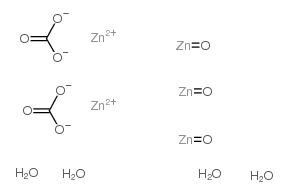3486-35-9
| 中文名 | 碳酸锌 |
|---|---|
| 英文名 | Zinc carbonate |
| 中文别名 | 菱锌矿 |
| 英文别名 |
Zinkcarbonat
carbonuredezinc EINECS 222-477-6 zincmonocarbonate naturalsmithsonite zincspar smithsonite MFCD00151660 |
| 密度 | 4,398 g/cm3 |
|---|---|
| 沸点 | 333.6ºC at 760 mmHg |
| 分子式 | C2H8O13Zn5 |
| 分子量 | 566.97700 |
| 闪点 | 169.8ºC |
| 精确质量 | 559.64200 |
| PSA | 214.51000 |
| 外观性状 | 白色粉末 |
| 储存条件 | 1.贮存于阴凉、通风、干燥的库房中。不可与酸碱类物品共贮混运。注意防潮。运输过程中要防雨淋、受潮,防日晒、受热。 |
| 稳定性 | 与30%双氧水作用,释出二氧化碳,形成过氧化物。当温度达到140℃左右时,开始分解。难溶于水,在沸水中加热变成碱式盐。 |
| 水溶解性 | 每100毫升水中的溶解克数: 4.692×10-5/20℃ |
| 计算化学 | 1.疏水参数计算参考值(XlogP):无 2.氢键供体数量:0 3.氢键受体数量:3 4.可旋转化学键数量:0 5.互变异构体数量:无 6.拓扑分子极性表面积63.2 7.重原子数量:5 8.表面电荷:0 9.复杂度:18.8 10.同位素原子数量:0 11.确定原子立构中心数量:0 12.不确定原子立构中心数量:0 13.确定化学键立构中心数量:0 14.不确定化学键立构中心数量:0 15.共价键单元数量:2 |
| 更多 | 1. 性状:白色细微无定形粉末。无臭、无味。 2. 密度(g/mL,25/4℃):4.42~4.45 3. 相对蒸汽密度(g/mL,空气=1):未确定 4. 熔点(ºC):未确定 5. 沸点(ºC,常压):未确定 6. 沸点(ºC,5.2kPa):未确定 7. 折射率:未确定 8. 闪点(ºC):未确定 9. 比旋光度(º):未确定 10. 自燃点或引燃温度(ºC):未确定 11. 蒸气压(kPa,25ºC):未确定 12. 饱和蒸气压(kPa,60ºC):未确定 13. 燃烧热(KJ/mol):未确定 14. 临界温度(ºC):未确定 15. 临界压力(KPa):未确定 16. 油水(辛醇/水)分配系数的对数值:未确定 17. 爆炸上限(%,V/V):未确定 18. 爆炸下限(%,V/V):未确定 19. 溶解性:不溶于水和乙醇,,微溶于氨 |
Synonym:Zinc carbonate (1:1); Zinc Monocarbonate; Carbonic acid, zinc salt Section 2 - COMPOSITION, INFORMATION ON INGREDIENTS
Risk Phrases: None Listed. Section 3 - HAZARDS IDENTIFICATION EMERGENCY OVERVIEW
The toxicological properties of this material have not been fully investigated. Potential Health Effects Eye: May cause eye irritation. Skin: May cause skin irritation. Ingestion: May cause gastrointestinal irritation with nausea, vomiting and diarrhea. Inhalation: May cause respiratory tract irritation. Chronic: No information found. Section 4 - FIRST AID MEASURES Eyes: Flush eyes with plenty of water for at least 15 minutes, occasionally lifting the upper and lower eyelids. Get medical aid. Skin: Get medical aid if irritation develops or persists. Flush skin with plenty of soap and water. Ingestion: If victim is conscious and alert, give 2-4 cupfuls of milk or water. Never give anything by mouth to an unconscious person. Get medical aid if irritation or symptoms occur. Inhalation: Remove from exposure and move to fresh air immediately. If not breathing, give artificial respiration. If breathing is difficult, give oxygen. Get medical aid if cough or other symptoms appear. Notes to Physician: Section 5 - FIRE FIGHTING MEASURES General Information: As in any fire, wear a self-contained breathing apparatus in pressure-demand, MSHA/NIOSH (approved or equivalent), and full protective gear. During a fire, irritating and highly toxic gases may be generated by thermal decomposition or combustion. Extinguishing Media: Use extinguishing media most appropriate for the surrounding fire. Section 6 - ACCIDENTAL RELEASE MEASURES General Information: Use proper personal protective equipment as indicated in Section 8. Spills/Leaks: Sweep up or absorb material, then place into a suitable clean, dry, closed container for disposal. Section 7 - HANDLING and STORAGE Handling: Wash thoroughly after handling. Remove contaminated clothing and wash before reuse. Use with adequate ventilation. Avoid contact with skin and eyes. Avoid ingestion and inhalation. Storage: Store in a cool, dry place. Keep containers tightly closed. Section 8 - EXPOSURE CONTROLS, PERSONAL PROTECTION Engineering Controls: Use adequate ventilation to keep airborne concentrations low. Exposure Limits CAS# 3486-35-9: Personal Protective Equipment Eyes: Wear appropriate protective eyeglasses or chemical safety goggles as described by OSHA's eye and face protection regulations in 29 CFR 1910.133 or European Standard EN166. Skin: Wear appropriate protective gloves to prevent skin exposure. Clothing: Wear appropriate protective clothing to prevent skin exposure. Respirators: A respiratory protection program that meets OSHA's 29 CFR 1910.134 and ANSI Z88.2 requirements or European Standard EN 149 must be followed whenever workplace conditions warrant respirator use. Section 9 - PHYSICAL AND CHEMICAL PROPERTIES Physical State: Solid Color: white Odor: odorless pH: Not applicable. Vapor Pressure: Not applicable. Viscosity: Not applicable. Boiling Point: Not applicable. Freezing/Melting Point: Decomposes. Autoignition Temperature: Not applicable. Flash Point: Not applicable. Explosion Limits, lower: Not available. Explosion Limits, upper: Not available. Decomposition Temperature: 300 deg C Solubility in water: Insoluble in water. Specific Gravity/Density: 4.398 Molecular Formula: ZnCO3 Molecular Weight: 125.3782 Section 10 - STABILITY AND REACTIVITY Chemical Stability: Stable under normal temperatures and pressures. Decomposed by acids with effervescence, evolution of carbon dioxide. Conditions to Avoid: Dust generation. Incompatibilities with Other Materials: Strong acids. Hazardous Decomposition Products: Carbon dioxide, zinc oxides. Hazardous Polymerization: Will not occur. Section 11 - TOXICOLOGICAL INFORMATION RTECS#: CAS# 3486-35-9: FG3375000 LD50/LC50: Not available. Carcinogenicity: Zinc carbonate - Not listed by ACGIH, IARC, or NTP. Other: See actual entry in RTECS for complete information. Section 12 - ECOLOGICAL INFORMATION Section 13 - DISPOSAL CONSIDERATIONS Dispose of in a manner consistent with federal, state, and local regulations. Section 14 - TRANSPORT INFORMATION IATA Not regulated as a hazardous material. IMO Not regulated as a hazardous material. RID/ADR Not regulated as a hazardous material. USA RQ: CAS# 3486-35-9: 1000 lb final RQ; 454 kg final RQ Section 15 - REGULATORY INFORMATION European/International Regulations European Labeling in Accordance with EC Directives Hazard Symbols: Not available. Risk Phrases: Safety Phrases: S 24/25 Avoid contact with skin and eyes. WGK (Water Danger/Protection) CAS# 3486-35-9: 0 Canada CAS# 3486-35-9 is listed on Canada's DSL List. CAS# 3486-35-9 is not listed on Canada's Ingredient Disclosure List. US FEDERAL TSCA CAS# 3486-35-9 is listed on the TSCA inventory. SECTION 16 - ADDITIONAL INFORMATION N/A |
|
生态学数据: 通常对水是不危害的,若无政府许可,勿将材料排入周围环境
|
| 安全声明 (欧洲) | S22-S24/25 |
|---|---|
| WGK德国 | 1 |
| 危险类别 | 9.2 |
| 海关编码 | 2836999000 |
| 海关编码 | 2836999000 |
|---|




 2.称取30g碳酸氢钾,溶解于300mL水中,保持温度在3℃左右,慢慢通入二氧化碳,使之饱和。用磁力搅拌器充分搅拌,缓慢滴加已经冷却到3℃的0.1mol/L的ZnSO4水溶液700mL,然后放在冰箱中,保持在10℃以下,静置3~4天后,再在20℃室温下放置2~3天。这样便会有微细的结晶性物质沉降下来。用水倾泻洗涤此结晶性沉淀,并使得溶液上部的漂浮性物质流出。将洗涤后的沉淀转移至滤纸上,用水洗涤至不含硫酸根离子。于130℃下干燥。
2.称取30g碳酸氢钾,溶解于300mL水中,保持温度在3℃左右,慢慢通入二氧化碳,使之饱和。用磁力搅拌器充分搅拌,缓慢滴加已经冷却到3℃的0.1mol/L的ZnSO4水溶液700mL,然后放在冰箱中,保持在10℃以下,静置3~4天后,再在20℃室温下放置2~3天。这样便会有微细的结晶性物质沉降下来。用水倾泻洗涤此结晶性沉淀,并使得溶液上部的漂浮性物质流出。将洗涤后的沉淀转移至滤纸上,用水洗涤至不含硫酸根离子。于130℃下干燥。